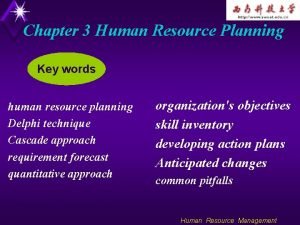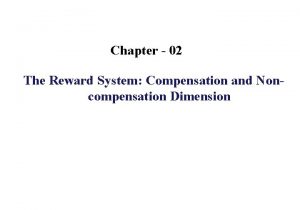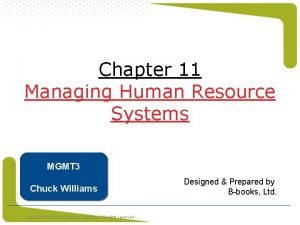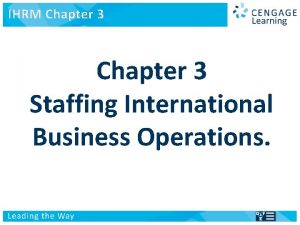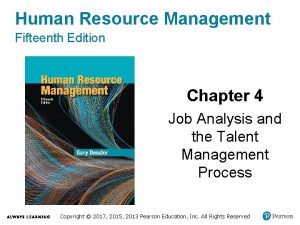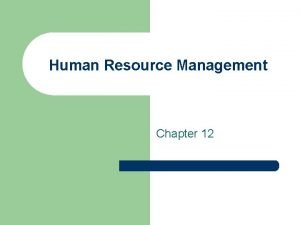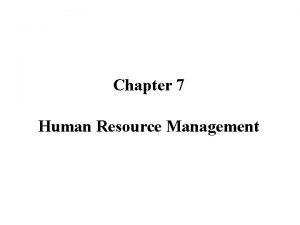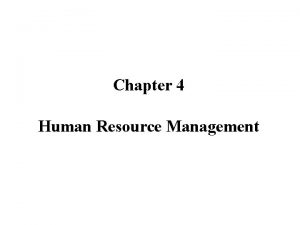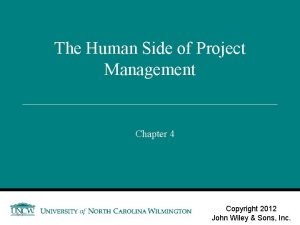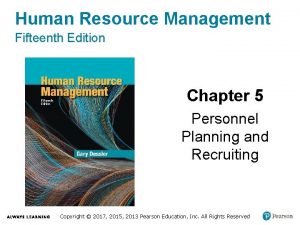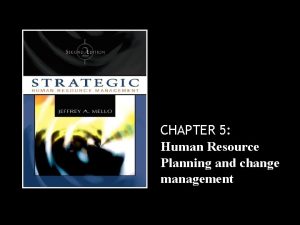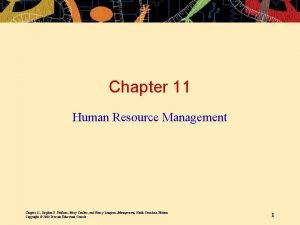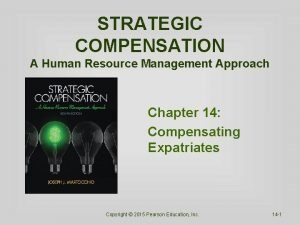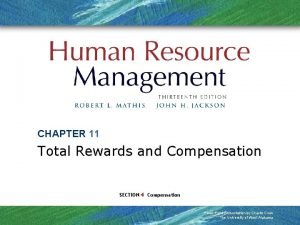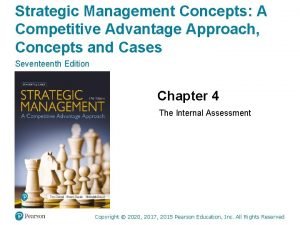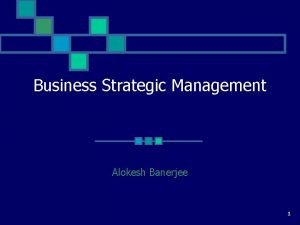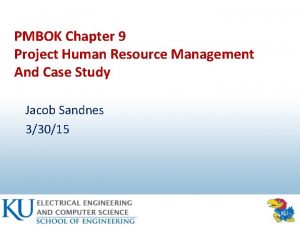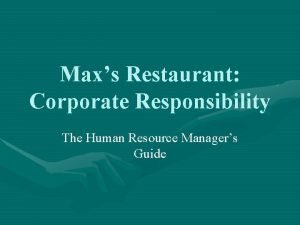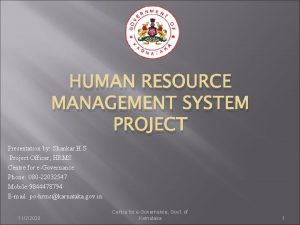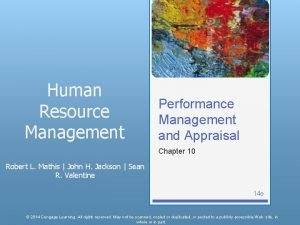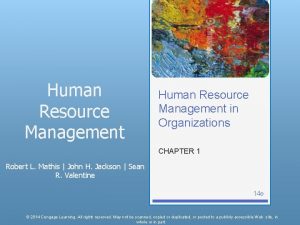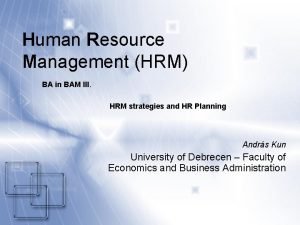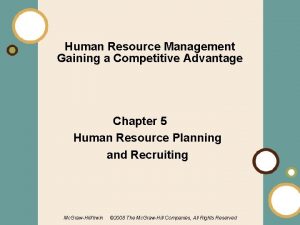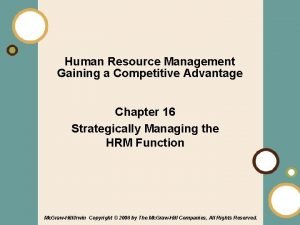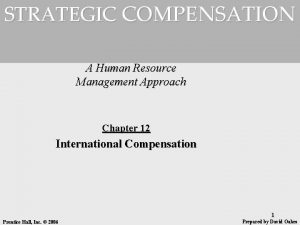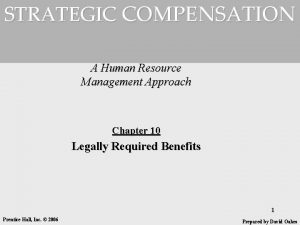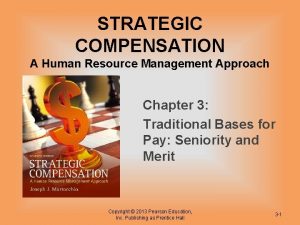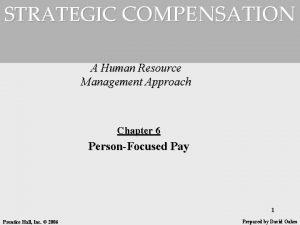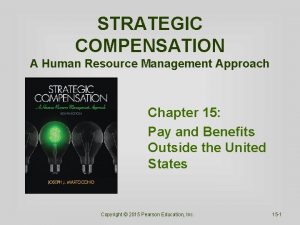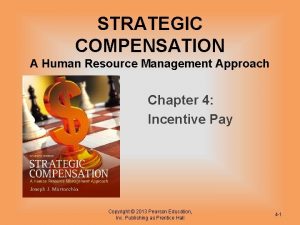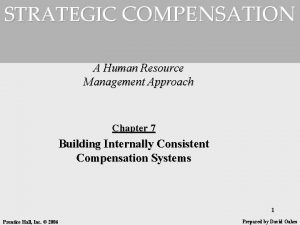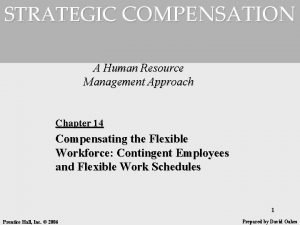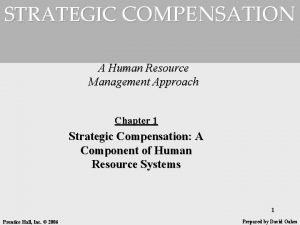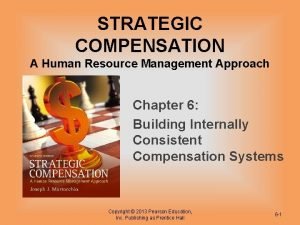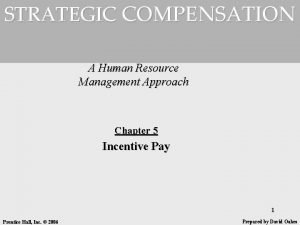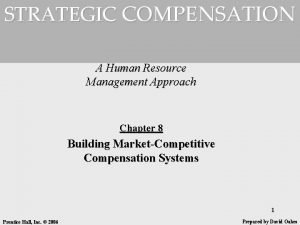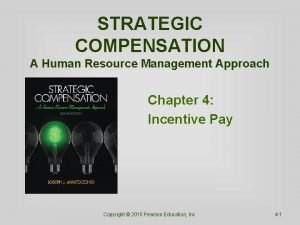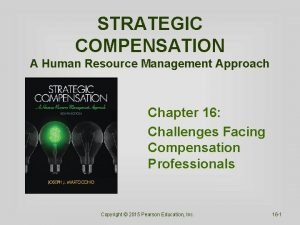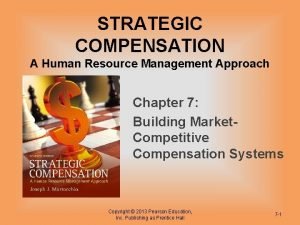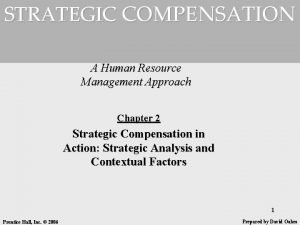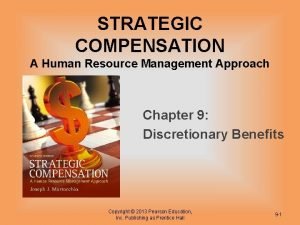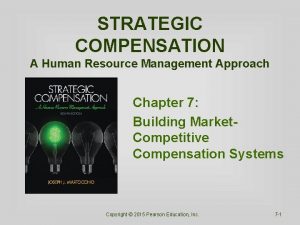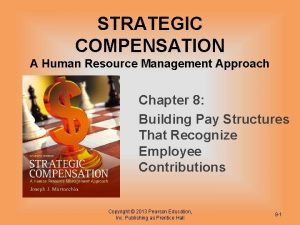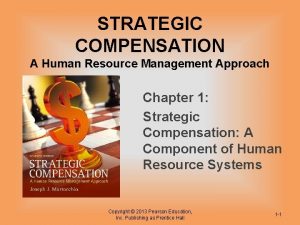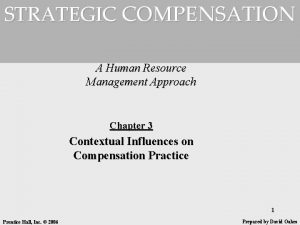STRATEGIC COMPENSATION A Human Resource Management Approach Chapter











































- Slides: 43

STRATEGIC COMPENSATION A Human Resource Management Approach Chapter 13: Compensating the Flexible Workforce: Contingent Employees and Flexible Work Schedules Copyright © 2015 Pearson Education, Inc. 13 -1

Learning Objectives 1. List and define each of the four groups of contingent workers and the reasons for U. S. employers’ increased reliance on them. 2. Discuss at least one compensation issue and one employee benefits issue for each of the four groups of contingent workers. 3. List the four categories of flexible work schedules. Copyright © 2015 Pearson Education, Inc. 13 -2

Learning Objectives 4. Summarize one pay and employee benefits issue for flexible work schedules, compressed workweeks, and telecommuting arrangements. 5. Describe at least three reactions unions have about the use of contingent work and flexible work schedule arrangements. 6. Identify two strategic issues and choices companies have regarding the use of contingent workers. Copyright © 2015 Pearson Education, Inc. 13 -3

Learning Objective 1 List and define each of the four groups of contingent workers and the reasons for U. S. employers’ increased reliance on them. Copyright © 2015 Pearson Education, Inc. 13 -4

Contingent Workers • 5. 7 million contingent workers employed in February 2005 • 27 million employees worked some form of a flexible schedule in May 2004 • Contingent workers and those on a flexible schedule made up 27. 5% of civilian workforce Copyright © 2015 Pearson Education, Inc. 13 -5

Copyright © 2015 Pearson Education, Inc. 13 -6

Types of Contingent Workers • Part-time employees • Temporary and on-call workers • Leased employees • Independent contractors, freelancers, consultants Copyright © 2015 Pearson Education, Inc. 13 -7

Employed Contingent Workers in February 2005 TYPE Part-time NUMBER 2, 294, 000 On-call 2, 500, 000 Temporary 1, 200, 000 Leased 813, 000 Copyright © 2015 Pearson Education, Inc. 13 -8

Part-Time Employees • Two kinds – Voluntary: chooses to work fewer than 35 hours – Involuntary: work fewer than 35 hours per week because they are unable to find fulltime employment Copyright © 2015 Pearson Education, Inc. 13 -9

Costs for Full- and Part-Time Employee Benefits, 2012 Copyright © 2015 Pearson Education, Inc. 13 -10

Job Sharing • Two or more part-timers perform one job • Reduces costs • Increases flexibility • Maintains productivity levels • May increase morale and loyalty Copyright © 2015 Pearson Education, Inc. 13 -11

Temporary Workers • Fill in for core employees • Help ease high demand periods • Help determine future employment needs • May be assessed for a core position • Don’t receive company benefits Copyright © 2015 Pearson Education, Inc. 13 -12

Leased Employee Arrangements • Lease company does all HRM functions • Fees either percentage of payroll or percentage per employee • Employees work for contract duration • Food service, security, building maintenance, administration Copyright © 2015 Pearson Education, Inc. 13 -13

Independent Contractors, Freelancers, and Consultants • Establish working relationships with companies on their own • Possess specialized skills – Ex: Adjunct faculty Copyright © 2015 Pearson Education, Inc. 13 -14

Rise in Use of Contingent Workers • Economic recessions • International competition • From manufacturing to service • More females in workforce • Runaway health insurance costs Copyright © 2015 Pearson Education, Inc. 13 -15

Service Divisions • Transportation • Communication • Public utilities • Wholesale trade • Retail trade • Government Copyright © 2015 Pearson Education, Inc. 13 -16

Learning Objective 2 Discuss at least one compensation issue and one employee benefits issue for each of the four groups of contingent workers. Copyright © 2015 Pearson Education, Inc. 13 -17

Federal Compensation Guidelines • ERISA • NLRA • ADEA • Title VII of 1964 Civil Rights Act • FLSA • COBRA Copyright © 2015 Pearson Education, Inc. 13 -18

Wage Comparisons, 2012 Benefit Full-Time Part-Time Management and professional workers $37. 05 $26. 70 Production workers $17. 57 $11. 09 Service workers $12. 16 $09. 18 Overall (all workers) $23. 22 $11. 95 Copyright © 2015 Pearson Education, Inc. 13 -19

Leased Workers’ Benefits • Leasing company is legal employer • In 2005, average weekly wage was $204 for part-time and $756 for full-time workers • Leasing and hiring companies responsible for discretionary benefits • Covered by safe harbor rules Copyright © 2015 Pearson Education, Inc. 13 -20

Safe Harbor Rules • Leased employees covered by leasing company’s pension plan • Nonintegrated employer contribution rate of 10% • Full and immediate participation in vesting • Leased employees less than 20% of nonhighly paid workforce Copyright © 2015 Pearson Education, Inc. 13 -21

Independent Contractors • Freelancers and consultants • Companies not responsible for: – Federal taxes – FLSA overtime or minimum wage – Workers’ compensation – ERISA, FMLA, NLRA, ADA, Title VII of Civil Rights Act • Economic reality test • Right to control test Copyright © 2015 Pearson Education, Inc. 13 -22

Economic Reality Test • Extent a worker controls methods and results • The control a company has on worker’s earnings • Importance of worker’s service to the company • Initiative or skill level required • Permanency, exclusivity, or length of assignment • Worker’s investment in materials or equipment Copyright © 2015 Pearson Education, Inc. 13 -23

Right to Control Test • IRC test to determine workers’ independence • 20 considerations, including: - Hiring, training, supervising, firing Hours Services Compensation Equipment, materials, location Copyright © 2015 Pearson Education, Inc. 13 -24

Learning Objective 2 • • Federal compensation guidelines Wage comparisons in September 2010 Benefits offered 2010 Leased workers’ benefits Safe harbor rules Independent contractors Economic reality test Right to control test Copyright © 2015 Pearson Education, Inc. 13 -25

Learning Objective 3 List the four categories of flexible work schedules. Copyright © 2015 Pearson Education, Inc. 13 -26

Flexible Work Schedules • Flextime • Compressed workweeks • Telecommuting Copyright © 2015 Pearson Education, Inc. 13 -27

Flextime • Set weekly not daily hours • May have to work core hours • Possible employer benefits - Lower tardiness and absenteeism - Higher productivity - Extended business hours • Possible employer drawbacks - Increased overhead costs - Coordination problems Copyright © 2015 Pearson Education, Inc. 13 -28

Compressed Workweeks • Example: – 40 hours in 3 to 4 days • Possible benefits - Can promote recruitment and retention - Can reduce commuting time - Can allow more family time Copyright © 2015 Pearson Education, Inc. 13 -29

Telecommuting • Employees work on-site and off-site • Constant direct contact with other employees • Possible benefits – Same as with flextime • Possible disadvantages – Less direct employee interactions – Makes performance appraisals difficult Copyright © 2015 Pearson Education, Inc. 13 -30

Telecommuting Arrangements • Satellite work centers • Neighborhood work centers • Nomadic executive office • Work off-site and/or on-site • Temporary or permanently Copyright © 2015 Pearson Education, Inc. 13 -31

Learning Objective 4 Summarize one pay and employee benefits issue for flexible work schedules, compressed workweeks, and telecommuting arrangements. Copyright © 2015 Pearson Education, Inc. 13 -32

Pay for Flexible Employees • Pay examples: – Alaska • A 10 hour day, 40 hour workweek premium pay after 10 hours a day instead of after 8 hours – Rhode Island • Time-and-one-half premium pay for work on Sundays and holidays in retail and certain other business is required Copyright © 2015 Pearson Education, Inc. 13 -33

Employee Benefits for Flexible Employees • Determination of paid vacation and sick leave for flexible employees is complicated (work fewer hours some months and more hours other months) • Treatment of paid time off for holidays Copyright © 2015 Pearson Education, Inc. 13 -34

Learning Objective 5 Describe at least three reactions unions have about the use of contingent work and flexible work schedule arrangements. Copyright © 2015 Pearson Education, Inc. 13 -35

Union Concerns • Employers exploit contingent workers by paying them lower wages and benefits • Employer’s efforts to get cheap labor will lead to poorly trained and less skilled workforce that will hamper competitiveness • Part-time employees are difficult to organize because their interests are centered on activities outside the workplace Copyright © 2015 Pearson Education, Inc. 13 -36

Union Concerns (cont’d) • Part-time employment erodes labor standards: often denied fringe benefits, job security, and promotion opportunities • Temporary employees generally have little concern for improving the productivity of a company • Union’s bargaining power becomes weak when companies demonstrate their abilities to perform effectively with temporaries Copyright © 2015 Pearson Education, Inc. 13 -37

Union Concerns (cont’d) • The long days of compressed workweeks or flextime could endanger workers’ safety and health, even if the workers choose these long days • Concerns about employee isolation, uncompensated overtime, and company monitoring in the home Copyright © 2015 Pearson Education, Inc. 13 -38

Learning Objective 5 • Union concerns Copyright © 2015 Pearson Education, Inc. 13 -39

Learning Objective 6 Identify two strategic issues and choices companies have regarding the use of contingent workers. Copyright © 2015 Pearson Education, Inc. 13 -40

Strategic Issues and Choices in Using Contingent and Flexible Workers Cost control objectives • Contingent employment allows for lower discretionary benefit cost and provides less generous amounts of such benefits • Well-trained contingent workers can reduce training costs Copyright © 2015 Pearson Education, Inc. 13 -41

Strategic Issues and Choices in Using Contingent and Flexible Workers Product and service innovation objectives • Contingent employment could bring in an influx of new employees with new ideas and minimize group think Copyright © 2015 Pearson Education, Inc. 13 -42

All rights reserved. No part of this publication may be reproduced, stored in a retrieval system, or transmitted, in any form or by any means, electronic, mechanical, photocopying, recording, or otherwise, without the prior written permission of the publisher. Printed in the United States of America. Copyright © 2015 Pearson Education, Inc. 13 -43
 Cascade approach in human resource management
Cascade approach in human resource management Noncompensation
Noncompensation Time management in human resource management
Time management in human resource management Organised retailing
Organised retailing Management is universal and everywhere
Management is universal and everywhere Strategic human resource
Strategic human resource Chapter 2 human resource management
Chapter 2 human resource management Chapter 9 human resource management
Chapter 9 human resource management Chapter 11 human resource management
Chapter 11 human resource management New approaches to organizing hr
New approaches to organizing hr Intro to human resource management
Intro to human resource management Human resources department structure
Human resources department structure Human resource management lecture chapter 1
Human resource management lecture chapter 1 Virtual assignment in ihrm
Virtual assignment in ihrm Chapter 4 job analysis and the talent management process
Chapter 4 job analysis and the talent management process Functions of hrm
Functions of hrm Chapter 7 human resource management
Chapter 7 human resource management Chapter 7 human resource management
Chapter 7 human resource management Human resource management chapter 4
Human resource management chapter 4 Project management chapter 4
Project management chapter 4 Replacement chart
Replacement chart Human resource management chapter 5
Human resource management chapter 5 Chapter 11 human resource management
Chapter 11 human resource management Strategic compensation
Strategic compensation Io model strategic management
Io model strategic management Cultural aspects of strategy choice
Cultural aspects of strategy choice Compensation approach
Compensation approach Incremental approach in strategic management
Incremental approach in strategic management Strategic management a competitive advantage approach
Strategic management a competitive advantage approach Crescive approach
Crescive approach Project human resource management pmbok ppt
Project human resource management pmbok ppt Resource management pmbok
Resource management pmbok Importance hrm
Importance hrm Human resource management in restaurants
Human resource management in restaurants Definition of induction in hrm
Definition of induction in hrm Hrms.shanker group.com
Hrms.shanker group.com Performance appraisal in human resource management
Performance appraisal in human resource management Current issues in human resource management
Current issues in human resource management Ba human resource management
Ba human resource management Identify job vacancy
Identify job vacancy Human resources management gaining a competitive advantage
Human resources management gaining a competitive advantage Downsizing
Downsizing Human resource management gaining a competitive advantage
Human resource management gaining a competitive advantage Hrm past questions and answers
Hrm past questions and answers
